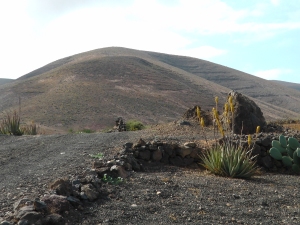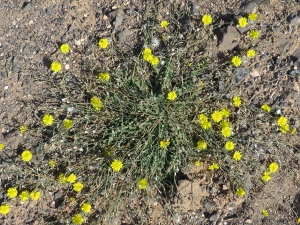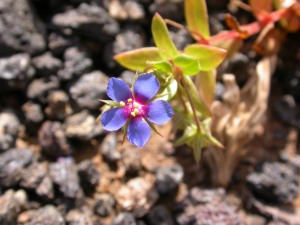Saturday 18 April: Northern Lanzarote and the Famara cliffs
On 17 June 1799, Humboldt wrote:
In this solitude, amidst so many uninhabited islets, we enjoyed for a long time the view of an austere and savage nature. The black mountains of Graciosa [surely the Famara cliffs on Lanzarote?] appeared like perpendicular walls of five or six hundred feet. Their shadows, thrown over the surface of the ocean, gave a gloomy aspect to the scenery. Rocks of basalt, emerged from the bosom of the water, wore the resemblance of the ruins of some vast edifice; their existence carried our thoughts back to the remote period when submarine volcanoes gave birth to new islands, or rent the continents asunder. Every thing which surrounded us seemed to indicate destruction and sterility.
Rising up from the sea immediately to the west of Órzola is a range of volcanic hills that extend out to the great cliffs that I saw yesterday from La Graciosa. It is one of the few parts of Lanzarote that gets a bit of moisture and shade, and is a special habitat, part of the Chinijo Archipelago Nature Reserve, with lots of unusual plants. I couldn’t resist walking up there, and it wasn’t that much of a climb. As ever, the initial challenge was in finding the track, which was set back a little to the west of the main road, and was soon revealing lots of new plants to me.
The first was this rather striking daisy, which kept cropping up all day. It is Glebionis coronaria (formerly Chrysanthemum coronarium) and is common in the Mediterranean and Asia, which it is used as leaf greens.
Its distant cousin, the equally distinctive Reichardia tingitana, lurked along the scrubby track as well. This was another one that would accompany me for large parts of the walk, along with the vivid pink Fagonia cretica in the family Zygophyllaceae.
While these plants had all found a sheltered spot in which to grow, it seemed remarkable that this dry volcanic landscape could also be farmed, yet often one sees little patches of crops. Looking closely, the soil in the ‘fields’ just felt like desiccated small lumps of lava.
There were bigger plants too. Most of the surrounding scrub contained the big Euphorbias and Verode (Kleinia neriifolia), and the alien from South America, Tree Tobacco (Nicotiana glauca), grew in the sunken path. It contains an alkaloid, anabasine, which apparently has various medicinal uses, though I don’t fancy smoking it.
Today was the day of endemics, though, even if I didn’t realise it at the time. I wanted a decent walk, so it just wasn’t practical to get the field guide out every time I saw something new. I didn’t have enough time back at the apartment either, so it was only once I was back in England that I figured out that this is the endemic Asteriscus intermedius.
In contrast Heliotropium ramosissimum is from west and north Africa and beyond.
Walking along, one expects to see something completely novel at every step, which is often the case. Since a very high proportion of the invertebrates are endemic too, every time a creature came into view the tendency was to assume that it must be something unusual, as Humboldt noted (see yesterday’s walk). That isn’t always the case, though, as my initial amazement was tempered with reality as I realised that a butterfly, though gorgeous, was in fact a Small Copper (Lycaena phlaeas) which we get at home in the village.
Gradually starting to climb up the volcanic hills along the course of the Camino Natural, other plants growing in the dust included Helianthemum canariense and yet more Fagonia cretica, plus a different, smaller Launaea compared with the one from yesterday and what I’m moderately sure is an endemic Ononis.
At this point my route met a small road and then the track started heading uphill rather more rapidly towards a place called La Quemada. Here, near the few houses were some shrubs, including the prickly Macaronesian endemic Rubia fruticosa, and my first sighting of the Lanzarote endemic Echium lancerottense. Unfortunately, my pictures of it were a bit rubbish, though I did finally get some half-reasonable photos of the dock Rumex vesicarius, but that isn’t nearly as unusual.
Now beginning to get a view of the many small volcanic peaks around me, the track ahead curved left towards the village of Yé. However, to the right the ground rose up in the direction of the cliffs. No footpath was marked, but it was clear that a motor vehicle had been up there at some point in the past, and the plants looked potentially more interesting too, so I struck off to climb the remaining 200m and get to the top of the Famara cliffs.
This terrain was indeed wonderful and it was only a few minutes before I was coming across a huge range of plants which I’d never seen before. First off was Ononis pendula, which is quite widely distributed around the Mediterranean and north African coast and what I think is another Canarian endemic Kickxia sagittata.
And then this completely stopped me in my tracks. I’ve never seen anything from the parasitic genus Orobanche and its relatives, and didn’t realise that that is what it was until much later. Unsurprisingly, it is a Lanzarote endemic, and is almost always parasitic on Launaea arborescens[1], though there isn’t any nearby in the photo, and I don’t remember whether there was any there or not!
Rare plants were all over the place on this part of the island, even if to a casual viewer it would appear pretty barren. Two more endemics were Lotus lancerottensis and the exquisite sea lavender Limonium puberulum, and by this stage I was beginning to get a bit overwhelmed, and had to stop for a small bite to eat.
However, even as I was sitting and looking at the view, it was impossible not to notice the amazing array of lichens covering the rocks. I’m not completely sure what they all were but two at least were probably Ramalina bourgeana and Rocella canariensis, which were identified as common local dye sources in the Arrecife museum which I visited the next day.
It just got better and better, even as I edged further yard by yard. Many of the plants I’d seen earlier in the day were up there too, but often in bigger colonies, and though I didn’t realise it at the time, ever more and more were endemics, such as Reseda lancerotae.
Towards the top of the cliffs the colours that the plants were adding to the ground was one of the most beautiful natural palettes I’ve ever seen. The reds of Mesembryanthemum nodiflorum were overshadowed by increasing amounts of the purple Limonium puberulum, plus a variety of yellows and an occasional sculptural form provided by Ferula lancerottensis and the delicate-shaped flower heads of Lobularia canariensis ssp. marginata.
And so finally I reached the top of the cliffs which I’d seen yesterday from La Graciosa. At 483m above sea level it was quite a spot, and an obvious place for assorted radio masts and the like. Dizzy enough with seeing so many amazing plants, the sight of La Graciosa from up there was an almost intoxicating spectacle, which at the time certainly felt like the most astonishingly magical, other-worldly view I’ve ever seen.
Unsurprisingly, then, Mirador del Río at the top of the cliffs is a major tourist attraction, and people pay a reasonable amount to go to the special viewing platform built into the cliff. The owners clearly want everyone to go in and pay the entrance fee, so the whole area at the top of the cliffs is fenced off and inaccessible from the road. Which proved to be a bit of a problem, since I’d come up via my cross country route and now had a fair bit of difficulty getting onto the road as it involved climbing over some rather high fences.
After being alone on my walk all morning it was a bit of a shock suddenly being surrounded by people, with coach parties, cars and cyclists all over the place, so the best bet was to walk down the small road along the top of the cliffs which relatively few people seemed to use.
Even there, though, were plants worth stopping for. Several Painted Lady butterflies (Vanessa cardui) were exploring the lavender which was growing all along the side of the road. Again, it was a Macaronesian endemic: Lavandula pinnata. I hope the mention of all these endemics isn’t getting boring; during the walk I had no idea which were specific to the Canaries or not, but was just astonished at the range and number of plant forms that I’d never seen before. It was anything but boring.
The botanical history of the plants is engaging too, with many of these species being first described by natural scientists I’ve studied: Andryala glandulosa by Lamarck, for instance, which reminds us that it is only relatively recently that so much of the natural world started to be catalogued and described in detail.
And, continuing on my way, clusters of plants were all along the roadside, many of course things I’d already seen, but often growing more luxuriantly here: the endemics Astericus intermedius, and Sonchus pinnatifidus with its distinctive leaves, plus Euphorbia regis-jubae, Verode (Kleinia neriifolia) and much else as the road descended a bit and the crater of Montaña Corona dominated the view.
At Finca la Corona there were a few scattered houses and a track headed off to the right, passing through an area where now there were crumbled remains of long-abandoned houses with some common weeds, Bituminaria bituminosa and Silybum marianum.
The track itself made straight for the cliff edge and wound its way down towards the salt pans 400m below. Though steps had been cut into the cliff and it was a good path, by this stage in my walk (and knowing how much further I had to walk to get back to Órzola) I couldn’t quite face the idea of the climb back up, so just spent the next hour dropping a small way down the cliffs and looking to see what I could find on this relatively shady, damp part of the island.
Almost immediately I noticed something unusual growing in crevices on the rocks by the side of the path near the top of the track. It was a vascular plant, but that was about all I knew. It was a succulent, one of the Crassulaceae, but it wasn’t illustrated in the Kanarenflora, so I didn’t figure out what it was until I got back to England. The genus Aichryson includes about 15 species, almost all of which are endemic to the Canaries, with one or two elsewhere in Macaronesia or the mainland. A handful were in the book, though none of them had the tight leaf form of this species.
From this spot on the cliffs there was a beautiful view of La Graciosa, often highlighted with some good plants in the foreground, so it was hard to take bad pictures. The number of flowers here was a bit overwhelming, with loads that I still haven’t quite managed to identify. The list included: Urospermum picroides; Echium lancerottense; Ononis pendula; Misopates salvagensis; Spergularia fimbriata. Lichens were everywhere too, and would need a special visit (and expertise).
Walking back up the track to rejoin the road I stopped to have a closer look at the birds which were very active and making lots of noise. Several of them were Spectacled Warblers (Sylvia conspicillata orbitalis), though others in the undergrowth I was less sure about.
By this stage I needed to make decent progress to get back to Órzola, so motored along the road through Yé. There were fewer plants of interest here, though lots of unfamiliar grasses that remain unidentified, plus weeds of waste ground, including Convolvulus althaeoides and some of its relatives, and Forsskaolea angustifolia.
Now turning off the road, the track cut back across country towards the point where I had earlier struck off towards the top of the cliffs many hours earlier. It was a nice route, a good path, and by now I was in my stride, speeding along keen to get back to the apartment. So, it was a bit of a surprise, after the last few days of safely walking across jagged lava fields, volcanic scree, and cliff edges that I should suddenly, without warning, just slip over and crash to the ground.
It wasn’t great. Not only were my wrist, arm and leg bleeding, but the camera I was holding at the time bore the full weight of my landing and crashed on the gravelly sand, and the other camera (the trusty Coolpix 4500) simply had the rest of my body land on it. Less bothered about the blood and the potential damage to my wrist, my immediate thought was that I had broken both cameras. Indeed, the shutter on the first wasn’t playing ball and it was gouged with scratches on one side. I’d also fallen on another Coolpix in the past which broke it, so I was convinced that the same was true of its replacement.
But, as the rest of this page bears witness, neither were broken. It took me about ten minutes to regain composure, wash the grazes, and then look to see what had caused the fall; almost imperceptibly the middle of the path raised up a couple of inches at a slight angle. My foot must have not quite landed on it firmly enough, and I slipped. Very tedious.
Still, it gave me a moment to pause and look at what was around me. Berthelot’s Pipits were running along the path too, and a gorgeous male Atlantic Lizard (Gallotia atlantica) sat immobile on a dry stone wall. At its base there was even some moss, the only bryophyte I found in my four days in Lanzarote, though it’s not at all clear what it is.
Vines are grown on this part of the island, with kilometres of terraces built to protect them, and like many places in Lanzarote, from a distance you can’t imagine there can be anything growing there.
But appearances are deceptive, and (as well as more unidentified grasses) there were several splashes of colour from (among others) Fumaria bastardii (probably), Reseda lancerotae, Silybum marianum, and Anagallis arvensis, the familiar Scarlet Pimpernel, in this case in a rather striking blue form.
Very keen now to get back, I stiffly ambled down the volcanic slopes covered in Verode (Kleinia neriifolia), catching a glimpse of the local subspecies of Kestrel (Falco tinnunculus dacotiae) and my first ever Hoopoe (Upupa epops)!
 Now, on the edge of old cultivated land I was back to the land of Opuntia and Aloe vera, as well as the Small Coppers still dancing around in the same spot I saw them first thing this morning. Finally, approaching Órzola I was back in the bad lands, the Malpaís, surrounded by the sharp, spiky, black lava rocks, Launaea arborescens and the big Euphorbias. A squished Algerian Hedgehog (Atelerix algirus) lay as roadkill. I was knackered.
Now, on the edge of old cultivated land I was back to the land of Opuntia and Aloe vera, as well as the Small Coppers still dancing around in the same spot I saw them first thing this morning. Finally, approaching Órzola I was back in the bad lands, the Malpaís, surrounded by the sharp, spiky, black lava rocks, Launaea arborescens and the big Euphorbias. A squished Algerian Hedgehog (Atelerix algirus) lay as roadkill. I was knackered.
The blog posts on the Lanzarote trip
- Sand and lava
- Following Humboldt
- A long walk to the cliffs [this current post]
- Shrubs, birds and aeroplanes
- A Lanzarote album
[1] Carlón, Luis, Gonzalo Gómez Casares, Manuel Laínz, Gonzalo Moreno Moral, Sánchez Pedraja, and Gerald M. Schneeweiss. “Phelipanche gratiosa.” Index of Orobanchaceae. Grupo Botánico Cantábrico, n.d. Web. 20 Oct. 2015. <http://www.farmalierganes.com/flora/angiospermae/orobanchaceae/Phelipanche/Phelipanche_gratiosa/Phelipanche_gratiosa.htm>.































































